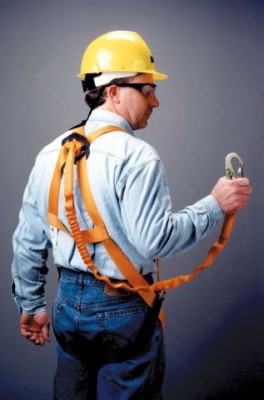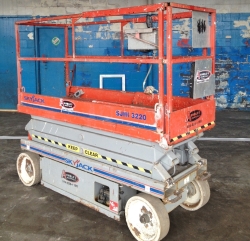
Over the years I have watched while the battle has raged over whether the use of personal fall arrest harnesses by scissor lift operators is appropriate. The rationale on each side of the issue; pro and con, is intelligent, compelling, and complete with opinions from well informed, knowledgeable people.
The core argument from the pro-harness side stems from the assertion that scissor lift operators are more or less subject to the same falling hazards as anyone else working at height, so why not wear a harness?
On the con-harness side of things, some of the many the arguments follow the logic that if a scissor lift operator who is tethered to the unit goes over the guard rail, the resulting force(s) exerted on the machine when his/her weight jerks to a stop at the end of the lanyard’s travel could be enough to cause the unit to topple, sending it and the operator down. In addition, so I’m told, as the unit plummets down with the operator in tow, the lanyard serves to worsen things by “slingshotting” the operator into the ground and possibly under the machine, resulting in even greater injury than if he/she were able to free fall or jump clear.
If that’s not enough, neither OSHA regulations or ANSI/SIA standards require the use of personal fall protection harnesses for operators of scissor lifts. In fact, in many cases manufacturers do not provide an anchor point to connect the snaphook of a lanyard to and, OSHA prohibits tying off to a guard rail as per 29CFR 1926.502(d)(23)); “Personal fall arrest systems shall not be attached to guardrail systems.”
Some other issues that I have heard from the con side have to do with things like how wearing a harness restricts the movement of the operator or that wearing a harness may actually lull the operator into a false sense of security. I could go on, but I won’t.
I am going to go on record here and state that I believe scissor lift operators should be required to wear a personal fall restraint system (PFRS) consisting of a full body harness and non-shock absorbing lanyard provided there is an approved anchor point to connect it to.
Allow me approach each point of the “con” argument and, for what it’s worth, chip in my two-cents.
First of all, take note of the suggestion for using a fall restraint harness rather than a fall arrest harness. Fall arrest systems are designed to stop a fall in progress while fall restraint systems prevent a fall from occurring… big difference. No fall means no excessive force on the unit, therefore no tip-over. The operator stays on the platform and the lift stays upright. Granted, a fall restraint harness may restrict the operator’s motion depending on the type of anchor point and how much mobility is actually required, but this is fair trade in exchange for preventing a fall and possible fatality.
 As for the “slingshot” effect, well, the laws of physics do not support that theory. A few centuries ago, Galileo discovered something we know today as, the law of falling bodies. Without going in to great detail here, it basically states that everything that falls accelerates toward the earth at a rate of 32 feet per second/per second, until reaching peak terminal velocity (top speed), which is about 120 mph. So, if a scissor lift tips over, the operator and the platform are going to travel toward the ground at approximately the same speed; there will be no “slingshot” effect and certainly no need to jump from the platform. In addition, an operator wearing a PFRS will not sustain further injury because of multiple impacts with the ground from bouncing after the initial impact with the ground.
As for the “slingshot” effect, well, the laws of physics do not support that theory. A few centuries ago, Galileo discovered something we know today as, the law of falling bodies. Without going in to great detail here, it basically states that everything that falls accelerates toward the earth at a rate of 32 feet per second/per second, until reaching peak terminal velocity (top speed), which is about 120 mph. So, if a scissor lift tips over, the operator and the platform are going to travel toward the ground at approximately the same speed; there will be no “slingshot” effect and certainly no need to jump from the platform. In addition, an operator wearing a PFRS will not sustain further injury because of multiple impacts with the ground from bouncing after the initial impact with the ground.
On the topic of jumping clear of the unit, there are serious concerns about the practicality of that notion. Even a conditioned athlete that is prepared and ready for the unit to tip would have difficulty picking the right moment to leap clear. When an aerial lift goes over it typically happens unexpectedly and quickly. The average operator is unlikely to have the physical prowess or presence of mind to do the right thing at the right time and even if he/she did, they would still have the actual fall to the ground with which to contend.
That brings us to OSHA regulations which, after all, are the law and the law says you don’t have to wear a harness to operate a scissor lift. I am going to avoid getting wrapped up in reg’s here the same way I do when I train operators, suffice to say that we are not attempting to determine if we have to wear it, but whether we should. Allow me to share a bit of wisdom that I usually impart to operators when they get a bit carried away with the law, which is; when you operate aerial lift devices, the only law you need to concern yourself with is the law of gravity. Respect for occupational safety and health laws will affect your relationship with OSHA while respect for gravity will affect your relationship with the ground!
As far as harnesses giving operators a false sense of security, it shouldn’t. It should give them a real sense of security. It is a simple fact that an operator wearing a PFRS is less likely to be killed by falling from the platform, which in itself is reassuring. It is also a fact that more scissor lift operators are killed by falling from the platform than by tipping the unit over (see table below) and besides, if the unit goes over for any reason, the effect on the operator will be ugly with or without a PFRS.
| Cause |
Boom-
Supported Lifts |
Scissor Lifts |
Unknown Type of Lift |
Total |
| Electrocutions |
62 |
6 |
- |
69 |
| Falls |
35 |
23 |
6 |
64 |
| Collapses or tip-overs |
23 |
21 |
- |
46 |
| Caught in/between |
11 |
- |
- |
14 |
| Struck by/against |
6 |
- |
- |
9 |
| Other causes |
5 |
- |
- |
5 |
| Total deaths |
142 |
55 |
10 |
207 |
The last point to look at is that there is not always an anchor point provided by the manufacturer to connect a PFRS to on most scissor lifts and, as mentioned earlier, we are not supposed to use the guard rails for that according to OSHA. To split hairs here, the wording of the regulation refers to tying off fall arrest systems and as you may recall, fall restraint is recommended, but let’s not split hairs, it’s not worth it. If there is no anchor point to tie off to, a PFRS cannot be used and that’s all there is to it.
However, anchor points and systems installed by the manufacturer are becoming more common and I have noticed that users/owners of large fleets are starting to have anchor points installed by their own (qualified) people under the direction of the manufacture or a professional engineer. I have also noticed that some anchor points are designed in such a way that permits excellent operator mobility by providing an attachment point that allows the snaphook to travel in much the same way a lifeline does in other fall protection systems. So, it would seem that like it or not, manufacturers and end users are moving toward acceptance and accommodation of harnesses for scissor lift operators which indicates that it may only be a matter of time, although possibly a long time, before OSHA does the same.
In the end, operators of scissor lifts should wear a personal fall restraint harness simply because it is the right thing to do. Although the risk of falling from a scissor lift may not be as prevalent as it is with other elevated work positions, one fall is one too many.
Rob Vetter
Director of Training
IVES Training Group
Note: This article was revised January 2012.
Did you enjoy this article? Sign up for our newsletter to receive more like this!